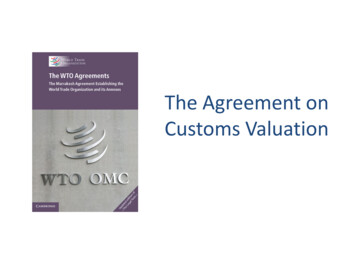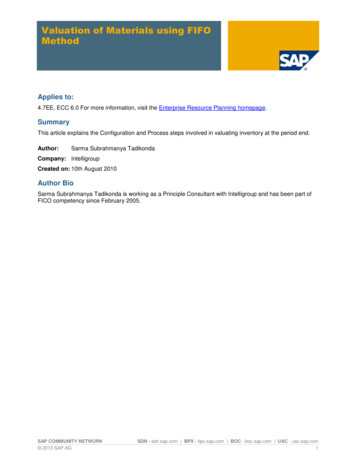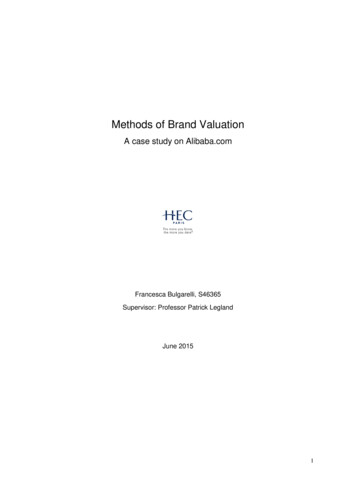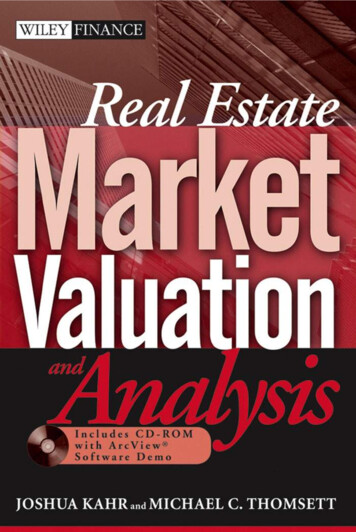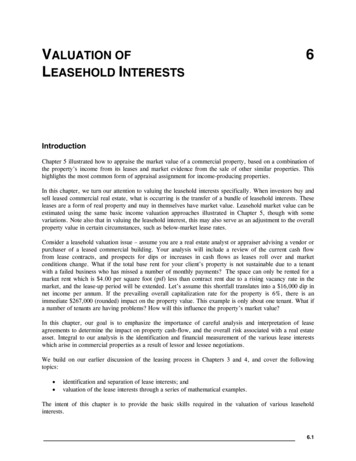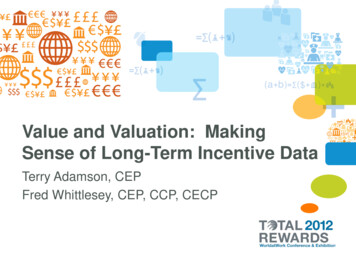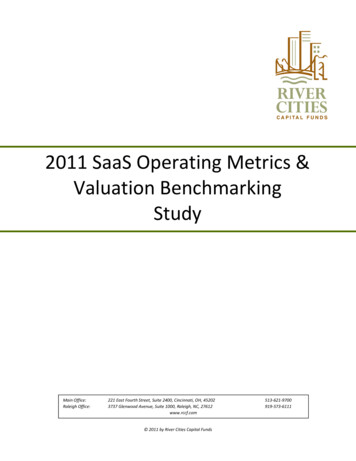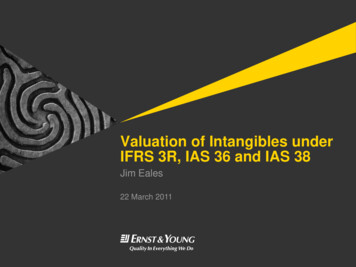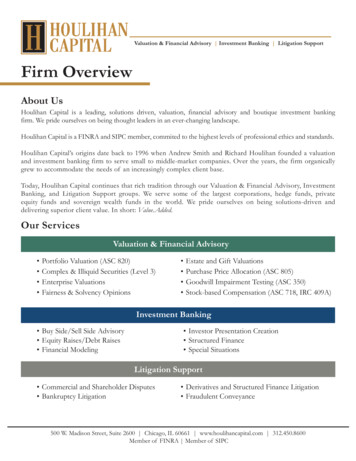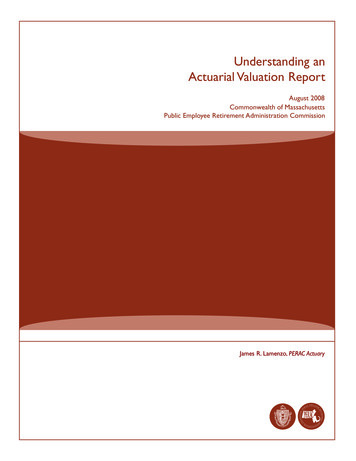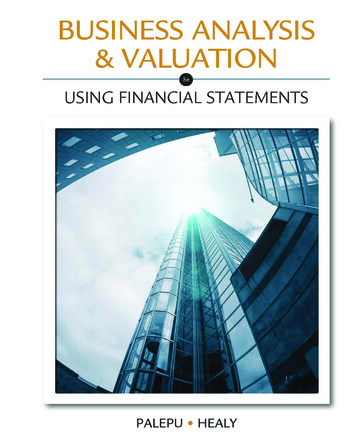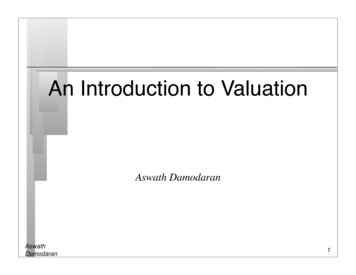
Transcription
An Introduction to ValuationAswath DamodaranAswathDamodaran1
Some Initial Thoughts" One hundred thousand lemmings cannot be wrong"AswathDamodaranWe thought we were in the top of the eighth inning,when we were in the bottom of the ninth.StanleyDruckenmillerGraffiti2
A philosophical basis for Valuation“Valuation is often not a helpful tool in determining when to sellhyper-growth stocks”, Henry Blodget, Merrill Lynch EquityResearch Analyst in January 2000, in a report on Internet CapitalGroup, which was trading at 174 then. There have always been investors in financial markets who haveargued that market prices are determined by the perceptions (andmisperceptions) of buyers and sellers, and not by anything as prosaicas cashflows or earnings. Perceptions matter, but they cannot be all the matter. Asset prices cannot be justified by merely using the “bigger fool”theory.Postscript: Internet Capital Group was trading at 3 in January 2001.AswathDamodaran3
Misconceptions about Valuation Myth 1: A valuation is an objective search for “true” value Truth 1.1: All valuations are biased. The only questions are how much andin which direction. Truth 1.2: The direction and magnitude of the bias in your valuation isdirectly proportional to who pays you and how much you are paid. Myth 2.: A good valuation provides a precise estimate of value Truth 2.1: There are no precise valuations Truth 2.2: The payoff to valuation is greatest when valuation is leastprecise. Myth 3: . The more quantitative a model, the better the valuation Truth 3.1: One’s understanding of a valuation model is inverselyproportional to the number of inputs required for the model. Truth 3.2: Simpler valuation models do much better than complex ones.AswathDamodaran4
I. Value first, Valuation to followSources of BiasWe don’t choose companies randomly to value:The information we use is always colored by the biases of thoseproviding the information: Annual reports and other data provided by the firm representmanagement’s spin on events Independent reports on the company (by analysts, journalists) will beaffected by their biases. If the stock is traded, the market price itself becomes a source of bias. AswathDamodaranInstitutional factors can add to the bias by skewing recommendationsin one direction or the other.Reward/punishment mechanisms may be tilted towards finding assetsto be under or over valued.5
Manifestations of Bias AswathDamodaranInputs to the valuation: Our assumptions about margins, returns oncapital, growth and risk are influenced by our biases.Post-valuation tinkering: The most obvious manifestation of biasoccurs after we finish the valuation when we add premiums (synergy,control) and assess discounts (illiquidity) for various factors. If we arebiased towards higher values, we tend to use premiums; if biasedtowards lower values, we discount.Qualitative factors: When we run out of all other choices, we tend toexplain away the difference between the price we are paying and thevalue obtained by giving it a name (strategic considerations )6
What to do about bias AswathDamodaranReduce institutional pressures: Institutions that want honest sell-side equityresearch should protect their equity research analysts who issue sellrecommendations on companies, not only from irate companies but also fromtheir own sales people and portfolio managers.De-link valuations from reward/punishment: Any valuation process where thereward or punishment is conditioned on the outcome of the valuation willresult in biased valuations. No pre-commitments: Decision makers should avoid taking strong publicpositions on the value of a firm before the valuation is complete. Self-Awareness: The best antidote to bias is awareness. An analyst who isaware of the biases he or she brings to the valuation process can either activelytry to confront these biases when making input choices or open the process upto more objective points of view about a company’s future.7
II. It is only an estimate:Sources of Uncertainty Estimation Uncertainty: Even if our information sources are impeccable, wehave to convert raw information into inputs and use these inputs in models.Any mistakes or mis-assessments that we make at either stage of this processwill cause estimation error.Real Uncertainty: AswathDamodaranFirm-specific Uncertainty: The path that we envision for a firm can prove to behopelessly wrong. The firm may do much better or much worse than we expected itto perform, and the resulting earnings and cash flows will be very different fromour estimates.Macroeconomic Uncertainty: Even if a firm evolves exactly the way we expected itto, the macro economic environment can change in unpredictable ways. Interestrates can go up or down and the economy can do much better or worse thanexpected. These macro economic changes will affect value.8
Responses of Uncertainty:The healthy ones.AswathDamodaran Better Valuation Models: Building better valuation models that use more ofthe information that is available at the time of the valuation is one way ofattacking the uncertainty problem. Even the best-constructed models mayreduce estimation uncertainty but they cannot reduce or eliminate the very realuncertainties associated with the future. Valuation Ranges: A few analysts recognize that the value that they obtain fora business is an estimate and try to quantify a range on the estimate. Some usesimulations and others derive expected, best-case and worst-case estimates ofvalue. Probabilistic Statements: Some analysts couch their valuations in probabilisticterms to reflect the uncertainty that they feel. Thus, an analyst who estimates avalue of 30 for a stock which is trading at 25 will state that there is a 60 or70% probability that the stock is under valued rather than make the categoricalstatement that it is under valued.9
Responses to uncertainty:Unhealthy ones. AswathDamodaranPassing the buck: Some analysts try to pass on responsibility for theestimates by using other people’s numbers in the valuation. If thevaluation turns out to be right, they can claim credit for it, and if itturns out wrong, they can blame others (management, other analysts,accountants) for leading them down the garden path.Giving up on fundamentals: A significant number of analysts give up,especially on full-fledged valuation models, unable to confrontuncertainty and deal with it. All too often, they fall back on moresimplistic ways of valuing companies (multiples and comparables, forexample) that do not require explicit assumptions about the future. Afew decide that valuation itself is pointless and resort to reading chartsand gauging market perception.10
What to do about uncertainty. AswathDamodaranYou can reduce estimation uncertainty but you cannot do much aboutreal uncertainty (other than treat it as risk and build it into yourdiscount rates)In general, analysts should try to focus on making their best estimatesof firm-specific information – how long will the firm be able tomaintain high growth? How fast will earnings grow during thatperiod? What type of excess returns will the firm earn?– and steeraway from bringing in their views on macro economic variables.11
III. Is bigger better?Sources of Complexity AswathDamodaranThe tools are more accessible: Computers and calculators havebecome far more powerful and accessible in the last few decades. Withtechnology as our ally, tasks that would have taken us days in the precomputer days can be accomplished in minutes.There is more information for us to work with: On the other side,information is both more plentiful, and easier to access and use. Wecan download detailed historical data on thousands of companies anduse them as we see fit.12
Cost of complexity AswathDamodaranInformation Overload: More information does not always lead tobetter valuations. In fact, analysts can become overwhelmed whenfaced with vast amounts of conflicting information and this can lead topoor input choices. The problem is exacerbated by the fact thatanalysts often operate under time pressure when valuing companies.Black Box Syndrome: The models become so complicated that theanalysts using them no longer understand their inner workings. Theyfeed inputs into the model’s black box and the box spits out a value. Ineffect, the refrain from analysts becomes “The model valued thecompany at 30 a share” rather than “We valued the company at 30a share”.Big versus Small Assumptions: Complex models often generatevoluminous and detailed output and it becomes very difficult toseparate the big assumptions from the small assumptions.13
The principle of parsimony AswathDamodaranThe basic principle: When valuing an asset, we want to use thesimplest model we can get away with.Don’t go looking for trouble and estimate inputs that you do not haveto. You can mangle simple assets using complicated valuation models.All-in-one valuation models that try to value all companies, bydefinition, will be far more complicated than they need to be, sincethey have to be built for the more complex company that you will runinto.14
Approaches to Valuation AswathDamodaranDiscounted cashflow valuation, relates the value of an asset to thepresent value of expected future cashflows on that asset.Relative valuation, estimates the value of an asset by looking at thepricing of 'comparable' assets relative to a common variable likeearnings, cashflows, book value or sales.Contingent claim valuation, uses option pricing models to measurethe value of assets that share option characteristics.15
Basis for all valuation approaches The use of valuation models in investment decisions (i.e., in decisionson which assets are under valued and which are over valued) are basedupon a perception that markets are inefficient and make mistakes in assessingvalue an assumption about how and when these inefficiencies will get corrected AswathDamodaranIn an efficient market, the market price is the best estimate of value.The purpose of any valuation model is then the justification of thisvalue.16
Discounted Cash Flow Valuation What is it: In discounted cash flow valuation, the value of an asset isthe present value of the expected cash flows on the asset.Philosophical Basis: Every asset has an intrinsic value that can beestimated, based upon its characteristics in terms of cash flows, growthand risk.Information Needed: To use discounted cash flow valuation, youneed to estimate the life of the asset to estimate the cash flows during the life of the asset to estimate the discount rate to apply to these cash flows to get presentvalue AswathDamodaranMarket Inefficiency: Markets are assumed to make mistakes inpricing assets across time, and are assumed to correct themselves overtime, as new information comes out about assets.17
Discounted Cashflow Valuation: Basis forApproachwhere CFt is the expected cash flow in period t, r is the discount rate appropriategiven the riskiness of the cash flow and n is the life of the asset.Proposition 1: For an asset to have value, the expected cash flows have to bepositive some time over the life of the asset.Proposition 2: Assets that generate cash flows early in their life will be worthmore than assets that generate cash flows later; the latter may howeverhave greater growth and higher cash flows to compensate.AswathDamodaran18
a. Going Concern versus Liquidation ValuationIn liquidation valuation, we valueFigure 1.1: A Simple View of a Firmonly investments already madeAssetsLiabilitiesAssets in PlaceExisting InvestmentsGenerate cashflows todayInvestments alreadymadeDebtGrowth AssetsExpected Value that will becreated by future investmentsInvestments yet tobe madeEquityBorrowed moneyOwner’s fundsWhen valuing a going concern, we value bothassets in place and growth assetsAswathDamodaran19
b. Equity Valuation versus Firm ValuationFirm Valuation: Value the entire businessEquity valuation: Value just theequity claim in the businessAswathDamodaran20
Equity ValuationAswathDamodaran21
Firm ValuationAswathDamodaran22
c. Three pathways to DCF value Classic DCF valuation: Discount cash flows (to firm or equity) back atthe appropriate discount rate (cost of capital or equity). The presentvalue of the cash flows is the value of equity or the firm. The effects ofdebt financing are built either into the cash flows (with equityvaluation) or into the cost of capital (with firm valuation)Adjusted Present Value approach: Value the firm as if it were all equityfunded and add the financial effects of debt to this value.Value of business Value of business with 100% equity financing Presentvalue of Expected Tax Benefits of Debt – Expected Bankruptcy Costs Excess Returns approach: The value can be written as the sum ofcapital invested and the present value of excess returns: Value of business Capital Invested today Present value of excessreturn cash flows from both existing and future projectsAswathDamodaran23
Advantages of DCF Valuation AswathDamodaranSince DCF valuation, done right, is based upon an asset’sfundamentals, it should be less exposed to market moods andperceptions.If good investors buy businesses, rather than stocks (the Warren Buffetadage), discounted cash flow valuation is the right way to think aboutwhat you are getting when you buy an asset.DCF valuation forces you to think about the underlying characteristicsof the firm, and understand its business. If nothing else, it brings youface to face with the assumptions you are making when you pay agiven price for an asset.24
Disadvantages of DCF valuation Since it is an attempt to estimate intrinsic value, it requires far moreinputs and information than other valuation approachesThese inputs and information are not only noisy (and difficult toestimate), but can be manipulated by the savvy analyst to provide theconclusion he or she wants.In an intrinsic valuation model, there is no guarantee that anything willemerge as under or over valued. Thus, it is possible in a DCF valuationmodel, to find every stock in a market to be over valued. This can be aproblem for equity research analysts, whose job it is to follow sectors and makerecommendations on the most under and over valued stocks in that sector equity portfolio managers, who have to be fully (or close to fully)invested in equitiesAswathDamodaran25
When DCF Valuation works best This approach is easiest to use for assets (firms) whose cashflows are currently positive and can be estimated with some reliability for future periods, and where a proxy for risk that can be used to obtain discount rates isavailable. It works best for investors who either have a long time horizon, allowing the market time to correct its valuationmistakes and for price to revert to “true” value or are capable of providing the catalyst needed to move price to value, aswould be the case if you were an activist investor or a potential acquirerof the whole firmAswathDamodaran26
Relative Valuation What is it?: The value of any asset can be estimated by looking athow the market prices “similar” or ‘comparable” assets.Philosophical Basis: The intrinsic value of an asset is impossible (orclose to impossible) to estimate. The value of an asset is whatever themarket is willing to pay for it (based upon its characteristics)Information Needed: To do a relative valuation, you need an identical asset, or a group of comparable or similar assets a standardized measure of value (in equity, this is obtained by dividing theprice by a common variable, such as earnings or book value) and if the assets are not perfectly comparable, variables to control for thedifferences AswathDamodaranMarket Inefficiency: Pricing errors made across similar orcomparable assets are easier to spot, easier to exploit and are muchmore quickly corrected.27
Choices with multiples Equity or Firm: Multiples can be scaled to just equity value (marketprice per share, market capitalization), to firm value (debt plus equity)or to the value of operating assets (debt plus equity minus cash)Scaling variable: The market value can be scaled to Earnings: The choices can range from equity earnings (EPS, Net Income)to operating income (EBIT or EBITDA). Book Value: The choices can include book value of equity or book valueof capital (debt plus equity) Revenues AswathDamodaranCurrent, Trailing or Forward Values: The values used for the scalingvariable can be from the last financial year (current), the last fourquarters (trailing) or some future period (forward).28
Choosing the Comparable firms AswathDamodaranIdentical firm(s): Try to find one, two or a few companies that lookvery similar to the firm that you are valuing. In effect, you are lookingfor a twin firm that is traded by the market.Sector: A far more common choice is to consider all firms in the sectorthat the firm operates in to be comparable firms.Valuation-based comparables: Firms that look like your firm in termsof cash flow, growth and risk characteristics.29
Making the comparison AswathDamodaranDirect comparison: In this approach, analysts try to find one or two companiesthat look almost exactly like the company they are trying to value and estimatethe value based upon how these “similar” companies are priced.Peer Group Average: In the second, analysts compare how their company ispriced (using a multiple) with how the peer group is priced (using the averagefor that multiple). Implicit in this approach is the assumption that whilecompanies may vary widely across a sector, the average for the sector isrepresentative for a typical company.Peer group average adjusted for differences: Recognizing that there can bewide differences between the company being valued and other companies inthe comparable firm group, analysts sometimes try to control for differencesbetween companies. In many cases, the control is subjective: a company withhigher expected growth than the industry will trade at a higher multiple ofearnings than the industry average but how much higher is left unspecified. Ina few cases, analysts explicitly try to control for differences betweencompanies by either adjusting the multiple being used or by using statisticaltechniques.30
Advantages of Relative Valuation Relative valuation is much more likely to reflect market perceptionsand moods than discounted cash flow valuation. This can be anadvantage when it is important that the price reflect these perceptionsas is the case when the objective is to sell a security at that price today (as in the case of anIPO) investing on “momentum” based strategies AswathDamodaranWith relative valuation, there will always be a significant proportion ofsecurities that are under valued and over valued.Since portfolio managers are judged based upon how they perform ona relative basis (to the market and other money managers), relativevaluation is more tailored to their needsRelative valuation generally requires less information than discountedcash flow valuation (especially when multiples are used as screens)31
Disadvantages of Relative Valuation AswathDamodaranA portfolio that is composed of stocks which are under valued on arelative basis may still be overvalued, even if the analysts’ judgmentsare right. It is just less overvalued than other securities in the market.Relative valuation is built on the assumption that markets are correctin the aggregate, but make mistakes on individual securities. To thedegree that markets can be over or under valued in the aggregate,relative valuation will failRelative valuation may require less information in the way in whichmost analysts and portfolio managers use it. However, this is becauseimplicit assumptions are made about other variables (that would havebeen required in a discounted cash flow valuation). To the extent thatthese implicit assumptions are wrong the relative valuation will also bewrong.32
When relative valuation works best. This approach is easiest to use when there are a large number of assets comparable to the one being valued these assets are priced in a market there exists some common variable that can be used to standardize theprice This approach tends to work best for investors who have relatively short time horizons are judged based upon a relative benchmark (the market, other portfoliomanagers following the same investment style etc.) can take actions that can take advantage of the relative mispricing; forinstance, a hedge fund can buy the under valued and sell the over valuedassetsAswathDamodaran33
Contingent Claim (Option) Valuation Options have several features They derive their value from an underlying asset, which has value The payoff on a call (put) option occurs only if the value of the underlyingasset is greater (lesser) than an exercise price that is specified at the timethe option is created. If this contingency does not occur, the option isworthless. They have a fixed life AswathDamodaranAny security that shares these features can be valued as an option.34
Option Payoff DiagramsStrike PriceValue of AssetPut OptionCall OptionAswathDamodaran35
Direct Examples of Options AswathDamodaranListed options, which are options on traded assets, that are issued by,listed on and traded on an option exchange.Warrants, which are call options on traded stocks, that are issued bythe company. The proceeds from the warrant issue go to the company,and the warrants are often traded on the market.Contingent Value Rights, which are put options on traded stocks, thatare also issued by the firm. The proceeds from the CVR issue also goto the companyScores and LEAPs, are long term call options on traded stocks, whichare traded on the exchanges.36
Indirect Examples of Options AswathDamodaranEquity in a deeply troubled firm - a firm with negative earnings andhigh leverage - can be viewed as an option to liquidate that is held bythe stockholders of the firm. Viewed as such, it is a call option on theassets of the firm.The reserves owned by natural resource firms can be viewed as calloptions on the underlying resource, since the firm can decide whetherand how much of the resource to extract from the reserve,The patent owned by a firm or an exclusive license issued to a firm canbe viewed as an option on the underlying product (project). The firmowns this option for the duration of the patent.The rights possessed by a firm to expand an existing investment intonew markets or new products.37
Advantages of Using Option Pricing Models AswathDamodaranOption pricing models allow us to value assets that we otherwisewould not be able to value. For instance, equity in deeply troubledfirms and the stock of a small, bio-technology firm (with no revenuesand profits) are difficult to value using discounted cash flowapproaches or with multiples. They can be valued using option pricing.Option pricing models provide us fresh insights into the drivers ofvalue. In cases where an asset is deriving it value from its optioncharacteristics, for instance, more risk or variability can increase valuerather than decrease it.38
Disadvantages of Option Pricing Models AswathDamodaranWhen real options (which includes the natural resource options and theproduct patents) are valued, many of the inputs for the option pricingmodel are difficult to obtain. For instance, projects do not trade andthus getting a current value for a project or a variance may be adaunting task.The option pricing models derive their value from an underlying asset.Thus, to do option pricing, you first need to value the assets. It istherefore an approach that is an addendum to another valuationapproach.Finally, there is the danger of double counting assets. Thus, an analystwho uses a higher growth rate in discounted cash flow valuation for apharmaceutical firm because it has valuable patents would be doublecounting the patents if he values the patents as options and adds themon to his discounted cash flow value.39
What approach would work for you? AswathDamodaranAs an investor, given your investment philosophy, time horizon andbeliefs about markets (that you will be investing in), which of the theapproaches to valuation would you choose?Discounted Cash Flow ValuationRelative ValuationNeither. I believe that markets are efficient.40
The more quantitative a model, the better the valuation Truth 3.1: One’s understanding of a valuation model is inversely proportional to the number of inputs required for the model. Truth 3.2: S
